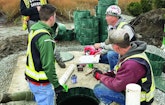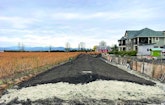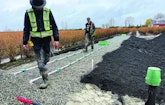
Technicians from Fraserway Prekast and Canadian Wastewater Solutions install the new tanks at Abbotsford, British Columbia. At left, a technician from PumperGuys Tank Service, empties one of the old tanks. The tank delivery truck is parked on a road built because of the high water table, and the same site was used for the sand bed. (Photos courtesy James Stiksma)
The old onsite system was failing at a rural property outside Abbotsford, British Columbia, and construction of a crude oil pipeline coming from Alberta brought a new system.
The pipeline ran through the property, and the old drainfield was right where work crews needed to set...










